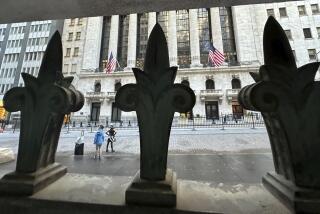Look out below if long rates go higher
It was easy for many small investors to ignore the credit marketsâ woes a few months ago, when the crisis was centered in high-risk mortgages owned by big-money investors.
Now, the credit crunch is getting a lot more up-close and personal for investors in markets far afield from dicey home loans -- including municipal and corporate bonds.
As in a bad horror movie, the monsterâs tentacles are groping around.
The troubles hitting other segments of the credit markets also are pointing up one of the biggest threats to the wobbling U.S. economy: the risk of a protracted jump in long-term interest rates.
Anyone who owns tax-free municipal bonds probably knows the problem there: The alphabet soup of insurance companies (MBIA, FGIC, etc.) that guarantee about half the U.S. muni market also guarantee many bonds backed by sub-prime mortgages. If sub-prime losses sink the insurers, their promises on muni bonds could be worthless.
The fact is, the vast majority of muni bonds donât need insurance, because defaults are rare. But that hasnât stopped some investors from pulling back from the market, which in turn depresses the value of outstanding bonds. Thatâs hurting the share prices of muni bond mutual funds popular with conservative, income-focused investors.
Shareholders of many âclosed-endâ muni bond funds, in particular, have taken a pounding in recent days. These funds, which trade on major stock exchanges, often use borrowed money to juice their bond bets.
One favorite form of borrowing by the funds is via so-called auction-rate securities. In a nutshell, auction-rate debt is floating-rate debt that resets weekly or monthly.
Borrowers in that market pay low rates as long as there are plenty of lenders to fund the debt. But as skittish brokerages and other investors have curtailed their lending, the auction-rate market has choked up, forcing borrowers to pay steep penalty rates.
Some closed-end fund shareholders, fearing a drag on their returns, have bailed, pulling shares of many of the funds down more than 5% this week.
The picture also has worsened for corporate junk bond mutual funds, another favorite holding of small investors. As the housing and mortgage crisis saps the economy, it raises the risk that highly leveraged companies (i.e., junk borrowers) will have trouble paying their debts. So prices of junk bonds are sinking.
The average junk mutual fund is down 3.4% this year, according to Morningstar Inc.
As bondsâ prices fall, their yields rise. The yield on an index of 100 junk bonds tracked by KDP Investment Advisors hit a five-year high of 9.63% on Friday, up from 9.03% two weeks ago.
Of course, moves like that often can spell opportunity.
Jon Schotz, co-founder of Saybrook Capital, a Santa Monica-based investment fund that focuses on muni bonds, says he was buying the auction-rate debt of some municipalities this week as annualized yields jumped into double digits.
As for conventional muni bonds that have private insurance, Schotz says, âI wouldnât get all panicky if I was a retail holder,â even if thereâs a chance the insurance becomes worthless. As long as a muni issuerâs finances are in decent shape, Schotz says, itâs going to make the interest payments it owes investors.
States, cities and other muni issuers, he says, usually have bought insurance for their bonds just to make them more easily marketable, not because anyone really worried that they might default.
Apart from market-specific jitters, thereâs another reason yields on longer-term muni and corporate bonds have been pushed up in recent weeks: Investors also have been demanding higher yields on Uncle Samâs bonds, which set the floor for other securities.
On Thursday, the yield on the 10-year U.S. Treasury note reached 3.8%, a five-week high, before inching down to 3.77% on Friday.
Short-term Treasury yields, by contrast, remain near their recent multiyear lows, on expectations that the Federal Reserve will continue to cut its benchmark short-term rate to counter the housing marketâs threat to the economy.
Why are longer-term Treasury yields rising? It could just be temporary market indigestion. But it also may be that some investors are growing uncomfortable accepting such paltry yields on Treasuries when, by some measures, inflation pressures are rising.
The latest Reuters/University of Michigan consumer sentiment survey, issued Friday, showed a jump in peopleâs average expectation for the one-year inflation rate, to 3.7% from 3.4% in January.
Despite the weakened economy, prices of many commodities, including soybeans, coffee and platinum, keep rising. The Reuters/Jefferies CRB index of 19 commodities hit a record high this week.
Because inflation effectively erodes fixed-rate bond yields, investors typically push up long-term yields when theyâre worried about the outlook for prices. That is not at all what the struggling economy needs.
A continuing advance in long-term interest rates could wreak more havoc in the housing market, driving mortgage rates up and devastating the hopes of strapped homeowners who want to refinance.
Whatâs more, higher yields in the corporate and municipal bond markets would make borrowing more expensive for those issuers at a time when the Fed is desperate to increase access to money in the credit-starved economy.
A sustained jump in long-term interest rates âis the Fedâs nightmare scenario,â said John Silvia, chief economist at Wachovia Corp. in Charlotte, N.C.
On Wall Street, many people already seem braced for a nightmare: Merrill Lynch & Co. said this week that its monthly survey of money managers worldwide showed that the percentage that have built up hefty cash cushions was the highest since immediately after the Sept. 11, 2001, terrorist attacks.
Usually when investors are expecting the worst to happen, it doesnât. Then again, the housing marketâs collapse and the credit crunch it has induced have consistently exceeded nearly everyoneâs worst-case scenarios so far.
--
More to Read
Inside the business of entertainment
The Wide Shot brings you news, analysis and insights on everything from streaming wars to production â and what it all means for the future.
You may occasionally receive promotional content from the Los Angeles Times.










